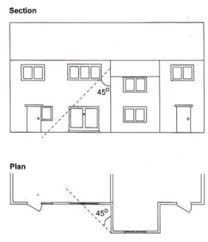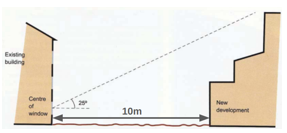Fast track planning application service requirements
The Royal Borough of Kingston upon Thames recognises that there will be occasions when you might require a quicker decision, for example, it could be that you have a builder on standby or you are engaged in a construction timetable and therefore you need to ensure that a development is started or completed by a certain date.
In order to facilitate this we offer a fast-track service. The purpose of the service is to accelerate the determination of an application for a decision to be quicker than the statutory determination date (normally eight weeks), for an additional fee on top of the statutory fee.
How to submit
All planning applications must be submitted via the Planning Portal.
The request for the fast-track service must be stated at the start of the proposal description on the application form on submission, see below. Your application will not be eligible for fast track if you do not do this.
Example description
- (Fast Track) Erection of a single storey rear extension
- (Fast Track) Erection of single storey rear extension (6.0m in depth, maximum height of 3.7m and eaves height of 2.7m)
- (Fast Track) Application for a Certificate of Lawful Development Proposed (Householder) erection of a single storey detached domestic garden outbuilding
For applications submitted electronically via The Planning Portal you must adhere to the following guidelines:
- Submit all necessary documents in one ‘go’
- The maximum print size for any drawing is A3. DO NOT submit drawings or plans that have to be printed at A2, A1 or A0, as we will not accept these, and your application will be deemed invalid
- Maximum single attachment file size of 5MB. Maximum application file size of 25MB
- All drawings should be attached as .pdf files (file types for non-drawings are .jpg, .doc and .xls will also be accepted)
- Ensure all drawings are categorised by type, as presented on the Portal
- All plans and drawings must be accurately drawn, using a conventional metric scale such as 1:1250, 1:500, 1:200, 1:100 etc, and must be drawn true to the stated scale(s). Plans/drawings must include a scale bar that refers to the paper size, for example: 1:100 on A3, and must also include key dimensions and must not contain disclaimers such as ‘not to scale’ and ‘do not scale’ (with the exception of perspective drawings). All plans should be drawn on the same paper size
- Plans and drawings should not be submitted as one combined PDF document. They should be presented on separate PDFs and titled accordingly i.e Existing and Proposed Front Elevation with the drawing number.
- The clearest way to present proposals is to group ‘existing’ and ‘proposed’ drawings side by side, using the same scale for both
- Annotated dimensions must be included on the floor plans, site plans, elevation drawings, and section or level plans
- Each plan or drawing should have a title box stating: the address and proposal; the title of the drawing (for example ‘existing rear elevation, proposed first floor plan etc’); the date, scale of the drawing and the drawing number, with revisions clearly identified. Plans or drawings must be correctly labelled
- Each plan or drawing must be fully annotated, for example a line between two properties should be annotated to say ‘boundary fence’, and distances from boundaries should be provided
- All plans must include a North arrow
- Please refrain from including any personal or sensitive data or information on drawings or documents e.g telephone numbers, email addresses, signatures, car registration numbers, and photographs that include people’s faces etc
- For the purposes of your planning application, ‘existing’ means the situation on the ground at the time of submitting an application. If planning permission or a certificate of lawful development has been obtained for a proposal, or part of, which the applicant intends to implement but has not yet commenced, these works must be included as part of the proposed plans or drawings and must form part of the application description. You should indicate on the plans or drawings the reference number of any element of the proposal that has previously been granted planning permission or benefits from a Lawful Development Certificate
In addition to the National Validation Requirements the following information must be submitted with your Householder Application.
Validation requirements
| Requirement | When it's required | What's required | Guidance |
|---|---|---|---|
|
“45 Degree” Plans and Statement Can be included within any Daylight, Sunlight and Overshadowing Assessment |
All applications that involve extensions or the erection of outbuildings. |
These should be drawn at a scale of 1:50 or 1:100, they should accurately identify neighbouring building(s) and window(s) and when possible indicate the use of the room served by the window(s), and should be annotated to show the application of the 45 degree ‘rule’. Please note this test applies for both floor plan drawings and elevation drawings. If the proposal fails the 45 Degree rule in both the floor and elevation plans a Daylight and Sunlight Report should be submitted with the application.

Example of plans |
Royal Borough of Kingston upon Thames Residential Design SPD (Policy Guidance 17) The 45 degree rule of thumb / guidance is used to assess the impact a new building or extension can have on neighbouring properties in terms of safeguarding daylighting. This rule seeks to:
The Council applies the ‘45 degree rule’ in assessing development proposals. New buildings or extensions to existing buildings should not encroach on a line drawn at an angle of 45 degrees from the midpoint of the closest window to a habitable room in a neighbouring property The 45 degree rule is only an indicator and the acceptability of a development proposal will also be dependent on ground levels on site and the orientation of the buildings. |
|
“25 Degree” Elevation Plan and Statement
Can be included within any Daylight, Sunlight and Overshadowing Assessment |
All applications that involve extensions of 2 or more storeys, or where the resultant extension / development is above 2 storeys in height i.e roof extension, or involves the erection of an outbuilding of 2 or more storeys |
These should be drawn at a scale of 1:50 or 1:100, they should accurately identify neighbouring building(s) and window(s) and when possible indicate the use of the room served by the window(s), and should be annotated to show the application of the ‘25 degree rule’ If the proposal fails the “25 Degree” rule of thumb a Daylight and Sunlight Report should be submitted with the application.

Example of plans |
Royal Borough of Kingston upon Thames Residential Design SPD (Policy Guidance 18)
Loss of Light to Existing Windows New development should be designed so that new buildings or extensions to existing buildings stand a reasonable distance from the boundary of the property so as not to block an unreasonable amount of light from any existing windows of neighbouring properties. As such: proposed new buildings or extensions to existing buildings taller or closer than three or more times their height (measure from the the centre of the existing window of a neighbouring property) should not encroach on the angle to the horizontal subtended by the new development to the centre of the lowest window should be more than 25 degrees. |
| Time stamped photographs | All applications |
Photographs should show all sides of the application property, plus front and rear streetscene photos showing the application property and the neighbouring properties. Photographs should have been taken within 3 months of the date of the submission of the application. Photographs should be clearly labelled. The purpose of the photographs is to assist Officers in assessing your proposal, as such please ensure neighbouring properties are included within your photographs. |
The submission of photographs assists Officers in the assessment of your application. When taking the photographs please consider the purpose for which they are intended. As such, photographs should show the application property from a variety of angles and they should show the relationship of the application property with neighbouring properties including the location of the windows that serve the neighbouring properties. |